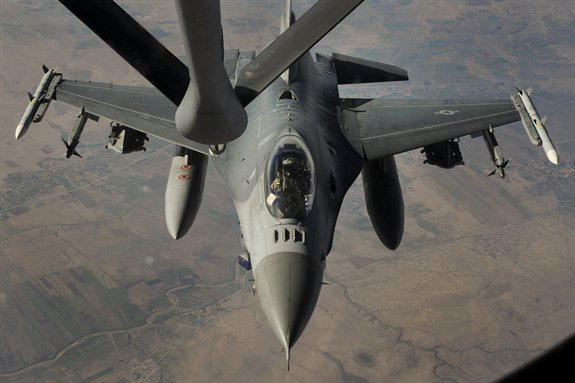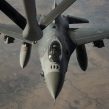
Operation Inherent Resolve: The War against Islamic State’s Oil Network
Publication: Terrorism Monitor Volume: 13 Issue: 1
By:

U.S. airstrikes launched on August 23 signaled the start of Operation Inherent Resolve. This is intended to eliminate the Islamic State terrorist group and the threat it poses to Iraq, Syria, the region and the wider international community. An important aim of the air attacks is to cripple oil facilities under Islamic State control; these are a critically important source of revenue for the jihadist group as it seeks to fund its insurgency. At present, the anti-Islamic State coalition conducting airstrikes in Iraq now includes the United States, France, the UK, Australia, Belgium, Denmark and the Netherlands. In addition, nations conducting airstrikes in Syria include the United States, Saudi Arabia, the United Arab Emirates, Jordan and Bahrain. [1] The fact that a significant proportion of airstrikes have continued to target oil-related infrastructure underlines the U.S. government’s assessment of the important of oil revenues to the group. As a result of this income, according to Carnegie Endowment for International Peace Vice President Marwan Muasher, the Islamic State has become “the world’s wealthiest and most financially sophisticated terrorist organization,” with oil generating the greatest proportion of the Islamic State’s revenue, followed by looting, local taxation, extortion and ransom (AFP, October 23, 2014).
Oil Wealth
The regional energy picture in areas controlled by the Islamic State and surrounding regions is complex, as energy infrastructure cuts across territories controlled by different groups. Nonetheless, some trends are clear: the UK risk management firm Maplecroft said on September 21 that the Islamic State controlled six out of Syria’s ten oil fields, including the large Omar facility, and at least four small fields in Iraq, including those at Ajeel and Hamreen, and sold up to 80,000 barrels of oil a day worth several million dollars through the regional black market (Financial Times, September 21, 2014). Much of this is either solid locally, including allegedly to the Syrian regime, or transported abroad via long established smuggling networks. Valerie Marcel, a Middle East and Africa energy specialist at Chatham House, has said:
At the same time, however, most analysts currently expect that Iraq’s more lucrative northern and southern oilfields will likely remain out of the Islamic State’s control for the time being. [3]
Airstrikes
In its fight against the Islamic State organization, the United States has used both drones and manned aircraft. By October 17, this force had conducted over 500 sorties in Iraq and Syria, including attacking a wide range of oil-related infrastructure, including Islamic State modular oil refineries (Wall Street Journal, October 17, 2014). On October 16-17, for instance, a coalition airstrike near Shadadi in Syria destroyed Islamic State oil collection equipment, several petroleum, oil and lubricants (POL) tanks and elements of the Islamic State’s oil producing, processing and transportation infrastructure, while also striking infrastructure that would hamper the Islamic State’s ability to operate oil tanker trucks at oil collection points. [4] A week later, two coalition airstrikes on October 22-23 east of Deir al-Zor in Syria destroyed Islamic State oil storage tanks, reducing the group’s ability to hold oil before shipping, which in turns creates bottlenecks throughout the oil production system. [5] 2014 ended with 10 Operation Inherent Resolve airstrikes against the Islamic State targets in Syria and Iraq on December 31, with coalition fighters and bombers conducting seven airstrikes in Syria, primarily near al-Hasakah, where two airstrikes destroyed four oil derricks (Kuwait News Agency, December 31, 2014). On January 5, coalition aircraft conducted 14 airstrikes in Syria, hitting five Islamic State crude oil collection points, a crude oil pipeline near Deir al-Zor, and other targets in Syria. [6]
Despite the air campaign, Islamic State militants have continued to attempt to seize energy assets in both Syria and Iraq. On October 30, for instance, the Islamic State announced that it had captured the large Sha’ar gas fields in Syria’s Homs province after fierce battles with Iraqi Army troops. Four days later claimed that it had seized nearby Jahar gas field as well (al-Akhbar [Beirut], November 3, 2014). Days later, on November 1, the Islamic State seized the gas wells in the al-Sha’ir oilfield located east of Homs and launched an attack on the al-Shahhar gas field in the same region. On the same day, Nasir al-Hariri, the secretary general for the National Coalition of Syrian Revolution and Opposition Forces, the organization for opposition groups in the Syrian civil war, warned that the Islamic State now controls:
He added that the Islamic State’s wealth also “increase[s] popular support for the organization” (al-Sharq al-Awsat, November 2, 2014).
In one area, however, the Islamic State brutality and coalition airstrikes are having an apparent effect, degrading the Islamic State’s ability to retain skilled oil field technicians. Following a series of fatal accidents at Iraqi oilfields seized by the Islamic State organization in June, the group has been forced to advertise for skilled technicians to manage the facilities it has captured. For instance, it has offered $225,000 a year for a manager to run their refineries, the most senior of several vacancies that the Islamic State organization is seeking to fill. The recruiting call has gone out via jihadist networks as far afield as North Africa and, closer to home, to black market agents in Iraq’s northern Kurdish region who have also been quietly advertising the vacancies. Robin Mills of Manaar Energy, a consultancy firm in Dubai said, “They are trying to recruit skilled professionals who are ideologically suitable. The money is good, but it’s not that good. A western oil exec[utive] posted to Iraq right now, let alone working for the Islamic State, would expect to earn a lot more than that” (The Times [London], November 1, 2014).
Financial Flows
Aside from coalition air attacks, the United States and allied governments are also attempting to tackle the Islamic State’s financial resources. On October 30, the U.S. Treasury Undersecretary for Terrorism and Financial Intelligence David Cohen said that, while U.S. and allied airstrikes had damaged small oil refineries captured by the Islamic State in eastern Syria, the strikes had slowed but not ended the organization’s ability to process and sell smuggled oil and petroleum products at discounted rates on the black market in Turkey and elsewhere. Meanwhile, in Iraq, dozens of local bank branches remain free to transfer money in and out of cities and towns controlled by the Islamic State, which allows the group some access to wider global financial systems. Cohen further noted that the Islamic State has “amassed wealth at an unprecedented pace,” including receiving at least $20 million in ransom payoffs since January, making the Islamic State, with the exception of some state-sponsored groups, “probably the best-funded terrorist organization we have confronted,” adding that stopping it will take time. “We have no silver bullet, no secret weapon to empty the Islamic State’s coffers overnight,” Cohen said, “This will be a sustained fight and we are in the early stages.” [7]
However, not all estimates of the Islamic State’s oil revenues are as high as earlier American estimates and the Islamic State’s actual financial resources may be somewhat lower. A confidential report prepared in October by Germany’s Federal Intelligence Service (Bundesnachrichtendienst – BND) concluded that the Islamic State organization earned much less from selling oil than had previously been reported, with one barrel of the Islamic State black market oil selling for $25, a fraction of the then-regular global market price of $80. The BND analysis estimated then current the Islamic State oil production at 28,000 barrels per day (bpd), of which 10,000 barrels at most are exported due to a combination of airstrikes, skilled personnel shortages and efforts to quash smuggled oil sales. These lower amounts meant that the Islamic State was consequently generating an annual income from oil exports of roughly $100s of millions, far less than the $1 billion initially estimated by U.S. Central Command (Süddeutsche Zeitung [Munich], November 6, 2014).
In addition, on December 8, the U.S. State Department’s new Special Envoy and Coordinator for International Energy Affairs Amos Hochstein said that the U.S.-led effort to reduce Islamic State oil revenues has been “remarkably successful in a relatively short period of time,” although he did not provide precise figures (Al-Monitor, December 8, 2014). The Department of Defense has also been cautiously optimistic about the effect of its military operations, including on the Islamic State’s oil revenues. During a November 4 Pentagon press briefing, when asked to assess the impact of the air-campaign after the first three months, Defense Department Press Secretary Rear Admiral John Kirby replied, “We do know that we’ve had an effect. We’ve eliminated streams of revenue from oil, both by hitting collection points and refineries. So, we know we’ve taken away from them millions of dollars per week that they could’ve been getting off the illicit sale of oil: refined oil.” [8]
Outlook
The U.S. government said on January 7 that since the U.S.-led campaign began in August more than 1,600 U.S. and allied airstrikes have been carried out in Iraq and Syria, dropping over 5,000 bombs on the Islamic State targets (al-Arabiya, January 8). U.S. and coalition nations have flown an average of more than 110 missions a day to support the operation, most to gather intelligence, with roughly 75 percent of the aircraft returning without dropping munitions (Los Angeles Times, January 5). However, these efforts have so far not dislodged the Islamic State militants from any major cities or areas in Syria and Iraq. Aside from the airstrikes, a more cautionary note on the abilities of the Iraqi armed forces was sounded by the Combined Joint Task Force-Operation Inherent Resolve commander, Lieutenant General James Terry, who, on December 18, said that it would take “a minimum of three years” before the Iraqi security forces and Kurdish peshmerga were capable of defeating the Islamic State. [9] What is also clear is that with President Obama’s announcement on November 7 that an additional 1,500 troops will be sent to Iraq, the U.S. government believes that the airstrikes and other international efforts to staunch the Islamic State oil revenues will not end the region’s jihadist threat anytime soon.
Dr. John C. K. Daly is a Eurasian foreign affairs and defense policy expert for The Jamestown Foundation and a non-resident fellow at the Central Asia-Caucasus Institute in Washington DC.
Notes
1. U.S. Central Command, News Release, October 27, 2014, https://www.defense.gov/news/newsarticle.aspx?id=123499.
2. “How the Islamic State is Able to Sell Oil on the Black Market,” Economic Policy Journal, September 22, 2014, https://www.economicpolicyjournal.com/2014/09/how-isis-is-able-to-sell-oil-on-black.html.
3. Eckart Woertz, “How Long Will the Islamic State Last Economically?,” Barcelona Center for International Affairs, Notes internacionals CIDOB, núm. 98, October 20, 2014, https://www.cidob.org/es/publicaciones/notes_internacionals/n1_98/how_long_will_isis_last_economically.
4. “Airstrikes Hit the Islamic State in Syria, Iraq,” U.S. Central Command, News Release, October 17, 2014, https://www.defense.gov/news/newsarticle.aspx?id=123444.
5. “Airstrikes Against the Islamic State Continue in Iraq, Syria,” U.S. Central Command, News Release, October 23, 2014, https://www.defense.gov/news/newsarticle.aspx?id=123471.
6. Combined Joint Task Force Operation Inherent Resolve, News Release, January 5, 2015, https://www.defense.gov/news/newsarticle.aspx?id=123912.
7. “Remarks of Under Secretary for Terrorism and Financial Intelligence David S. Cohen at The Carnegie Endowment For International Peace, ‘Attacking ISIL’s Financial Foundation,’” U.S. Treasury Department Press Release, October 23, 2014, https://www.treasury.gov/press-center/press-releases/Pages/jl2672.aspx.
8. Department of Defense Press Briefing, November 4, 2014, https://www.defense.gov/transcripts/transcript.aspx?transcriptid=5533.
9. Department of Defense Press Briefing, December 18, 2014, https://www.defense.gov/Transcripts/Transcript.aspx?TranscriptID=5559.





